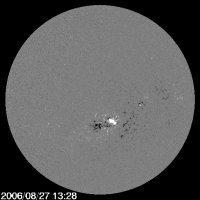Start of Next Solar Cycle?
30 August 2006
The level of solar activity goes through a cycle of maxima and minima with one cycle lasting roughly 11 years. Currently the Sun is around minimum at the end of the last cycle (no. 23). The new cycle, no. 24, is due and SOHO may have observed the first sign of its arrival.The level of solar activity is matched by the number of sunspots on the Sun's surface. Sunspots are regions with an increased density of magnetic field lines that pass through the Sun's surface. Inside these regions, the surface is some 2000 degrees cooler than normal and therefore appears dark, creating the distinctive appearance of sunspots.
Usually sunspots occur in pairs, with two sunspots of opposite sign as defined by the direction of the local magnetic field: N (outward magnetic field) and S (inward magnetic field). The relative position of the N (north) and S (south) sunspot is dependant on the pair's location on the Sun's surface and also changes with each solar cycle.
During cycle 23, on the Sun's northern hemisphere the orientation of all sunspot pairs is to have as leading and trailing spot the N and S spot, respectively, with respect to the Sun's rotation. On the southern hemisphere the orientation is reversed with the S spot leading and the N spot trailing.
 |
|
SOHO/MDI Magnetogram of the Sun with sunspot 905. |
With the next solar cycle this orientation is flipped in both hemispheres, as the Sun's global magnetic field reverses its orientation.
As a new cycle begins, the number of sunspots with the reverse orientation will increase and the ones with the orientation of the old cycle will decrease in number. In the transition period they can both occur on the Sun, as the two cycles have no sharp boundary and overlap.
A few weeks ago, one small candidate reverse sunspot was sited but it faded quickly (see related link to article at Science@NASA). Now, a large active region (no. 905) also with the reverse orientation is visible on the Sun's Earth-facing side, signalling the start of the next solar cycle.
SOHO constantly monitors the Sun and will continue to observe the evolution of the sunspots and the solar activity during the new solar cycle, which will culminate in the solar maximum in about 5,5 years time. Solar scientists predict that the upcoming solar maximum will be very active and could even be the most fierce in decades.

